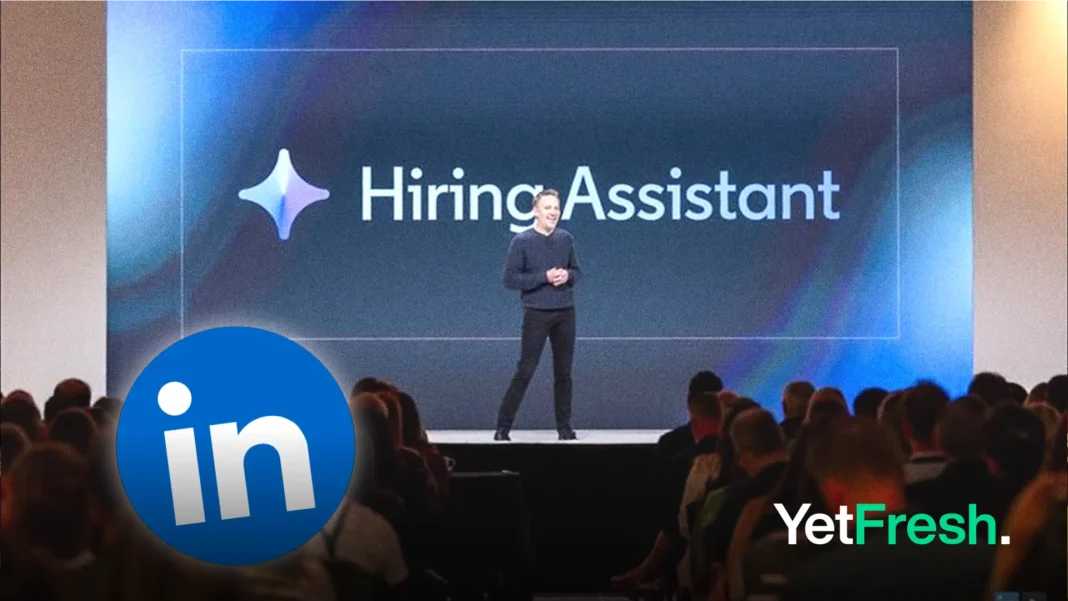No time to read? Just listen to the news!
TL;DR
- LinkedIn launches Hiring Assistant, an AI-powered tool that automates recruitment tasks, from crafting job descriptions to sourcing and engaging candidates
- Hiring Assistant is LinkedIn’s first “AI agent” targeting recruiters, currently live with select enterprise customers, with plans for a broader rollout
- The tool integrates with third-party systems, trained on LinkedIn’s vast data, and aims to streamline the hiring process by reducing manual work for recruiters
- LinkedIn focuses on perfecting Hiring Assistant’s user experience and technology, marking a significant step in harnessing AI for recruitment
LinkedIn, the leading professional networking platform, has unveiled its latest artificial intelligence (AI) tool, Hiring Assistant, designed to revolutionize the recruitment process. The new product aims to automate a wide range of tasks, from crafting job descriptions to sourcing and engaging with potential candidates.
Described as a milestone in LinkedIn’s AI trajectory, Hiring Assistant is the company’s first “AI agent” targeting one of its most lucrative user categories: recruiters. The tool is currently live with a select group of large enterprise customers, including AMD, Canva, Siemens, and Zurich Insurance, with plans for a broader rollout in the coming months.
LinkedIn has long been an early adopter of AI in its back-end operations, using the technology to generate accurate connection recommendations for users. However, the viral rise of generative AI in recent years has prompted the company to enhance its front-end capabilities. Leveraging its parent company Microsoft’s partnership with OpenAI, LinkedIn has introduced several AI-powered tools, such as learning coaches, marketing campaign assistants, and candidate sorters, all powered by OpenAI’s GPT language model.
Hiring Assistant takes LinkedIn’s AI efforts to the next level by significantly reducing the manual work required from recruiters. “It’s designed to take on a recruiter’s most repetitive task so they can spend more time on the most impactful part of their jobs,” said Hari Srinivasan, LinkedIn’s VP of product.
The tool allows users to upload full job descriptions or provide notes on desired qualifications, along with examples of job postings from other companies or roles. Hiring Assistant then generates a list of required qualifications and an initial pipeline of candidates. Recruiters can interact with the AI to refine their search, prioritizing skills over other indicators like location or education.
Trained on LinkedIn’s vast data, which includes 1 billion users, 68 million companies, and 41,000 skills, Hiring Assistant integrates with third-party application tracking systems. The company plans to introduce additional features soon, such as messaging and scheduling support for interviews and handling candidate follow-ups.
Unlike many of LinkedIn’s recently released AI features, Hiring Assistant is squarely aimed at the platform’s B2B business, specifically the products it sells to the recruitment industry. While the company has not provided recent updates on its Talent Solutions revenue, which surpassed $7 billion for the first time in July 2023, AI remains a significant business driver for LinkedIn. The growth in AI tool usage has already contributed to an increase in Premium subscriptions among ordinary consumers.
As LinkedIn continues to develop Hiring Assistant, the company remains focused on perfecting the user experience and the underlying technology. “This is all bleeding edge, and I mean everything from the experience and how our users are going to interact with it, to the technology that backs it,” said Erran Berger, VP of engineering at LinkedIn.
The introduction of Hiring Assistant marks a significant step forward in LinkedIn’s efforts to harness the power of AI to streamline the recruitment process. As the tool evolves and becomes more widely available, it has the potential to transform the way recruiters connect with talent, saving time and resources while improving the overall hiring experience for both employers and candidates.
Source: Tech Crunch




